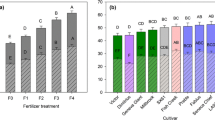Abstract
Willow (Salix spp.) is among the most promising energy crops to be grown on agricultural land and breeding research to increase biomass yield of this perennial crop is performed in Europe and North America. Biomass willows are grown in short rotation and harvests are performed every 3 to 5 years (i.e., at 3- to 5-year cutting cycles) for a period of up to 25 years. However, breeding programs to improve long-term biomass yield are often relying on the results of short-term screening studies performed on juvenile plants. A pre-requisite for successful breeding of perennial energy crops is thus the identification of relevant juvenile plant traits indicative of long-term plant performance under field conditions. In this study a number of juvenile plant traits, measured at various Salix genotypes grown in a short-term experiment were evaluated in terms of their capacity to predict the long-term performance in biomass production after the first and second cutting cycle. The objective was to develop a simple model linking juvenile plant traits such as shoot biomass, total leaf area and leaf nitrogen (N) concentration to the long-term biomass productivity of field-grown plants. A two-component regression model combining juvenile shoot biomass and leaf N concentration provided the highest prediction accuracy (coefficients of determination around 0.8). The model based on two easy-to-measure juvenile plant traits clearly has implications for willow breeding programs. The implications for breeding are discussed in the light of the possibilities and limitations associated with the chosen approach.





Similar content being viewed by others
References
Alexandersson H, Karlström C, Larsson-McCann S (1991) Temperature and precipitation in Sweden 1961–1990. Reference normals. Meteorology 81:1–88
Cameron KD, Philips IS, Kopp RF, Volk TA, Maynard CA, Abrahamson LP, Smart LB (2008) Quantitative genetics of traits indicative of biomass production and heterosis in 34 full-sib F1 Salix eriocephala families. Bioenerg Res 1:80–90
Christersson L, Sennerby-Forrse L, Zsuffa L (1993) The role and significance of woody biomass plantations in Swedish agriculture. For Chron 69:687–693
Gullberg U (1993) Towards making willows pilot species for coppicing production. For Chron 69:721–726
Jordan N, Boody G, Broussard W, Glover JD, Keeney D, McCown BH, McIsaac G, Muller M, Murray H, Neal J, Pansing C, Turner RE, Warner K, Wyse D (2007) Sustainable development of the agricultural bio-economy. Science 316:1570–1571
Karp A, Shield I (2008) Bioenergy from plants and the sustainable yield challenge. New Phytol 179:15–32
Kuzovkina Y, Weih M, Abalos Romero M, Charles J, Hurst S, McIvor I, Karp A, Trybush S, Labrecque M, Teodorescu T, Singh NB, Smart L, Volk TA (2008) Salix: botany and global horticulture. Horticult Rev 34:447–489
Larsson S (1997) Commercial breeding of willow for short rotation coppice. Aspects Appl Biol 49:215–218
Larsson S, Nordh N-E, Farrel J, Tweddle P (2007). Manual for SRC willow growers. Lantmännen Agroenergi AB, Örebro, Sweden (www.agroenergi.se). 18 p
Nordh N-E (2005) Long term changes in stand structure and biomass production in short rotation willow coppice. Doctoral thesis no. 2005: 120, Faculty of Natural Resources and Agricultural Sciences, Swedish University of Agricultural Sciences, Uppsala, Sweden
Robinson KM, Karp A, Taylor G (2004) Defining leaf traits linked to yield in short-rotation coppice Salix. Biomass Bioenergy 26:417–431
Rönnberg-Wästljung AC, Gullberg U, Nilsson C (1994) Genetic parameters of growth characters in Salix viminalis grown in Sweden. Can J For Res 24:1960–1969
Rönnberg-Wästljung AC, Glynn C, Weih M (2005) QTL analyses of drought tolerance and growth for a Salix dasyclados x Salix viminalis hybrid in contrasting water regimes. Theor Appl Gen 110:537–549
Smart LB, Volk TA, Lin J, Kopp RF, Phillips IS, Cameron KD, White EH, Abrahamson LP (2005) Genetic improvement of shrub willow (Salix spp.) crops for bioenergy and environmental applications in the United States. Unasylva 221:51–55
Tharakan PJ, Robison DJ, Abrahamson LP, Nowak CA (2001) Multivariate approach for integrated evaluation of clonal biomass production potential. Biomass Bioenergy 21:237–247
Tharakan PJ, Volk TA, Nowak CA, Abrahamson LP (2005) Morphological traits of 30 willow clones and their relationship to biomass production. Can J For Res 35:421–431
Trybush S, Jahodová Š, Macalpine W, Karp A (2008) A genetic study of a Salix germplasm resource reveals new insights into relationships among subgenera, sections and species. Bioenerg Res 1:67–79
Weih M, Nordh N-E (2002) Characterising willows for biomass and phytoremediation: growth, nitrogen and water use of 14 willow clones under different irrigation and fertilization regimes. Biomass Bioenergy 23:397–413
Weih M, Nordh N-E (2005) Determinants of biomass production in hybrid willows and the prediction of field performance from pot studies. Tree Physiol 25:1197–1206
Weih M, Didon UME, Rönnberg-Wästljung AC, Björkman C (2008) Integrated agricultural research and crop breeding: allelopathic weed control in cereals and long-term productivity in perennial biomass crops. Agricult Syst 97:99–107
Weih M, Rönnberg-Wästljung AC (2007) Shoot biomass is related to vertical leaf nitrogen gradient in Salix canopies. Tree Physiol 27:1551–1557
Acknowledgements
This research was funded by a grant from the Swedish Energy Agency, the Swedish University of Agricultural Sciences and the company Lantmännen Agroenergi AB to MW.
Author information
Authors and Affiliations
Corresponding author
Appendix
Appendix
Rights and permissions
About this article
Cite this article
Weih, M., Bonosi, L. Assessment of Genotype Ranking in Long-term Biomass Production of Salix Based on Juvenile Plant Traits: Breeding Implications. Bioenerg. Res. 2, 29–36 (2009). https://doi.org/10.1007/s12155-009-9031-4
Received:
Accepted:
Published:
Issue Date:
DOI: https://doi.org/10.1007/s12155-009-9031-4




